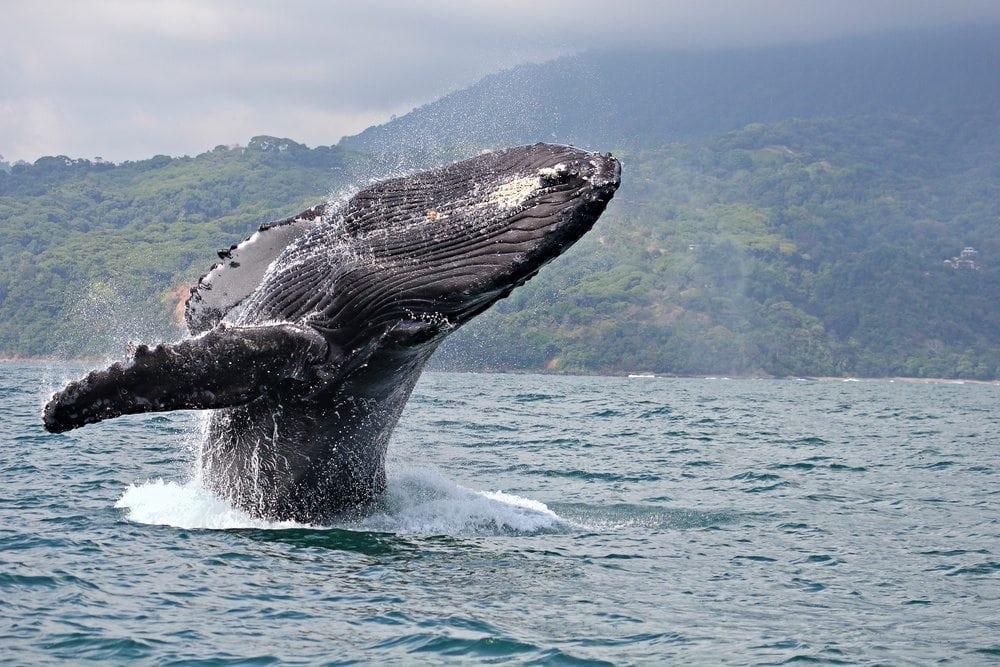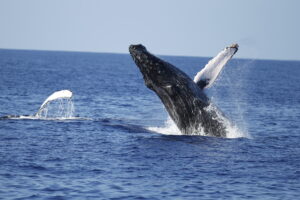Visiting a humpback whale habitat and seeing these magnificent beasts up close is an amazing experience.
From their mammoth size, to their impressive longevity, you may feel inconsequential in comparison. But don’t take our word for it! The next time you’re on Oahu be sure to check out the real thing! But in the meantime you can prepare yourself with this list of interesting facts about humpback whales.
See whales in the wild on a Whales and You Tour!
Join a Whales and You tour to see wild humpback whales in Oahu.
1. Humpback whales are smart
Not only are humpback whales smart, but they’re also quite vocal! Each population communicates through its own dialect, and sings its own whale song. But, whales aren’t born knowing how to sing. Each baby whale learns from other whales around them. Oddly enough, only the male whales sing.
2. Whale songs are long and LOUD!
Humpback whale songs are audible up to 20 miles away, and each song can be up to 20 minutes in length. The whales are known to repeat the same song over and over again for hours.
3. Krilling me softly …
The humpback whale diet includes a large amount of krill. Krill are a tiny marine animal, comparable to shrimp. It takes quite a lot of krill to make up the amount each whale needs on a daily basis – almost 1.5 tons!
4. Females for the win!
When it comes to length, the females are actually longer than the males. A female humpback whale can measure in at around 50 feet long, while the males are a bit shorter. Sometimes males are as much as 10 feet smaller than their female counterparts!
5. Whales are, like, really really big. (really)
The flippers are huge as well, making up as much as one-third of their total length. The tail can be a whopping 18 feet wide. All that length makes for a lot of weight. Humpback whales weigh as much as 40 tons. To give you some perspective, a standard car weighs under 2 tons!
6. Whales are globe-trotters
You’ve probably seen humpback whale pictures showing these amazing creatures in tropical waters. You’ve probably also seen them further north near Alaska. You can find them migrating just about anywhere in the Arctic, Atlantic, or Pacific Oceans though too. You’ll see them around Massachusetts, New York, and even in the Arabian Sea!
7. Whale population facts: 40,000 is 35% of what number?
It’s believed there are about 40,000 existing humpback whales currently in the world. The mammoth beasts are a bit slow, so they once were popular game for hunting.
Fortunately killing humpback whales is illegal now, although some countries continued to kill them until just a few decades ago. It’s projected that whales living now are less than 35 percent of the world’s original population.
8. Breaching to the choir
They love to jump out of the water – called breaching – and perform acrobatic twirls. They also enjoy poking just their heads out of the water, or slapping their tail around. The reasons for these activities aren’t known yet. It’s suspected these are ways humpback whales play, interact, and communicate with one another.

9. Whale pregnancy is a long-term commitment!
Humpback whales give birth to live young, with pregnancies usually lasting about a year. Adult female whales give birth about once every two or three years. Each baby whale needs about 100 pounds of milk per day to live!
10. Whales are rather introverted
While many populations of these whales are sizable, they don’t often congregate together. In fact, for the most part, they generally travel in pairs or groups of three or four. These small groups are called a pod, and may be made up of a mother whale and her children, or of a few whale friends.
11. One of the longest migrations around
Migration is a part of almost every sea creature’s life. But this is especially true for the humpback whale. This is one species that migrates further than almost any other. Humpbacks migrate about 16,000 miles in an average season. They migrate according to their two annual seasons. Seasons are differentiated according to their feeding and mating rituals. Feeding is usually in the summer months, and mating is usually in the winter months.
12. Humpback whales, the toothless wonders of the sea!
Humpback whales actually have no teeth! What you may see in pictures that look like teeth are actually called baleen plates. These plates act like a sieve, separating the water from all the tiny krill they eat!
13. Humpback whales have a unique way of breathing
These animals have not one, but two blow holes. There’s one for each of their lungs. Just how big are those lungs? About the size of a small automobile! Humpbacks don’t breathe like humans do. A humpback whale actually has to think about breathing, unlike humans, who breathe involuntarily. To go to sleep and still breathe, they’ll only shut off half their brain at a time.
14. The unique markings of whales’ underbellies
Each whale has a different design that can be found on its underbelly. The white markings are like human fingerprints. Scientists use these markings to recognize certain whales they may be studying.

Want to see some whales in person?
Whale season in Hawaii occurs from November until May. At Dolphins and You we often see these magnificent creatures on our swimming with dolphins tour. Join us for the opportunity to swim with wild dolphins, snorkel with sea turtles, and possibly witness humpback whales!













